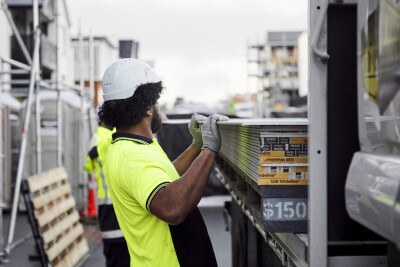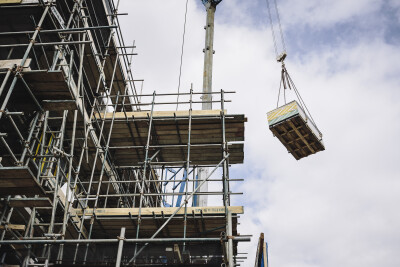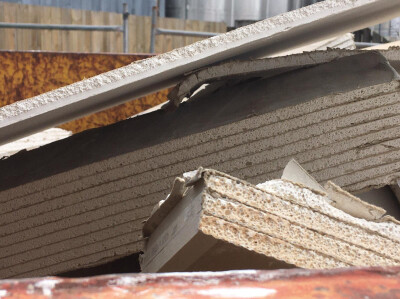Articles | Sustainability
The reusable packaging with a return rate of up to 98%
Friday, 20 September 2024
By Jamie Rodriguez
A packaging system that’s been around for almost a century is proving to be a sustainability success for one of Aotearoa New Zealand’s largest building materials companies.
Winstone Wallboards has been using timber pallets for delivering GIB® plasterboard and accessory products since starting business in the late 1920s. Made from untreated timber, the pallets are engineered for repeated use as well as being easy to repair and maintain. And, when their packaging days are over, they are recycled into other products such as compost or biofuel.
Winstone Wallboards delivery system also works as a collection system for returning pallets to its distribution facilities. The company works closely with its suppliers and merchants and has developed a practical process for keeping its pallets in circulation. Key to that is a customer credit return system to help encourage the return of pallets.
In 2023 the pallet return rate was a fraction over 96%. That means about 300,000 pallets were sent back to the company to be reused or recycled. The pallet return scheme represents savings in materials and costs, as well as diverting hundreds of tonnes of timber from landfill.
Collaboration and incentives critical to success
A GIB® plasterboard pallet has an average life of about three years.Pallets stay in circulation thanks to about 400 building merchants and the thousands of trade people on building sites who make sure they are returned to Winstone Wallboards rather than being dumped in skips.
At the time of placing an order with Winstone Wallboards, customers are charged a fee for the pallets which is refunded when the pallets are returned to the company. Over the past decade, the return rate for GIB® pallets has ranged from 95-98%. That’s more than 20 million pallet movements around the country.
“The success of the pallet return system in achieving a high return and reuse rate is ultimately based on having strong collaboration and communication between Winstone Wallboards, stores and trade customers so that product delivery, pallet collection and credit processes are all as painless as possible,” says Gordon White, Winstone Wallboards Residential Market Manager.
Winstone Wallboards operates a distribution system with facilities in Auckland, Tauranga, Wellington, and Christchurch that supply merchant stores and trade customers around the country. The system also works in reverse. Empty pallets are collected by the merchants and returned to the nearest distribution facility to be repaired and reused or collected by partner organisations for recycling.
How the return system works
The system starts when a trade customer places an order for GIB® products with a local merchant store. When confirming the order, Winstone Wallboards lets the merchant know how many pallets will be used for the delivery. The merchant includes a set charge, based on size, for each pallet when billing the trade customer.

Image 1: For clear identification of value, each pallet has its charge displayed on the side.
Orders are dispatched by Winstone Wallboards on pallets using its Delivered to Site (DTS) service which is available in Auckland, Hamilton, Tauranga, Wellington, and Christchurch. Alternatively, orders are delivered to merchant stores for dispatch to the trade customer from there.
Generally, when using the DTS service, GIB® products are unloaded from the pallets and are taken away by the GIB® delivery truck. However, the trade customer can request a pick-up later if the pallets need to be left on site for some reason.
Trade customers also have the option of picking up their order from a merchant store. They can return pallets to the store or organise the merchant to pick them up.
In both scenarios, the merchant issues a full credit for the pallet charge once they have been returned.
Empty pallets are stockpiled by the merchant and are picked up by an approved transport provider back to a GIB® distribution facility.
Why use wooden pallets
Winstone Wallboards has been using wooden pallets to transport GIB® products for more than 95 years as they:
• provide the best option to protect GIB® products during transport so they arrive in the best condition possible to customers
• are purpose-built to support heavy plasterboard loads that can weigh more than two tonnes
• can be easily repaired and reused, and then recycled at their end of life.

Image 2: Wooden pallets provide a strong base for transporting GIB plasterboard around the country and building sites.
To extend the life of pallets, they are repaired onsite at Winstone Wallboards distribution facilities. Pallets that have reached their end of life are retired and collected by partner organisations to be recycled into materials such as biofuel and garden mulch.These initiatives divert about 100 tonnes of wood from landfill every year. That’s about the same weight as a fleet of 50 cars.
It is estimated that construction and demolition materials make up about half of the waste we send to landfill in Aotearoa New Zealand. The built environment is also responsible for 15% of this country’s long-lived greenhouse gas emissions.
As BRANZ* points out there are opportunities to reduce building material waste at all stages of construction and demolition projects.
Reusable timber pallets are a good example of minimising waste in the first place and then reusing the materials in other ways.
• repair and reuse reduces waste and demand for new materials and saves money
• recycling diverts timber from landfill and helps reduce greenhouse gas emissions
• recycling also creates valuable materials like biofuel to replace polluting coal
* BRANZ is an independent research organisation that uses an impartial, evidence-based approach to improving the performance of the New Zealand building system.
The lifecycle of wooden pallets Winstone Wallboards uses pallets made by suppliers in Auckland and Christchurch. In 2023 about 36,000 new pallets were put into circulation. Made of untreated pine, pallets range in size from 2.4 metres to 6 metres for transporting GIB® plasterboard and 1.2 metres for carrying GIB® accessory products. They are engineered to take heavy loads. For example, a 2.4-metre pallet can carry up to two tonnes of GIB® plasterboard.
Once a pallet has been used, it is returned to a Winstone Wallboards distribution facility where it is inspected and, when necessary, repaired by an onsite team, before reuse.
Retired pallets from the North Island are collected by Green Gorilla and chipped into pieces about the size of a 50-cent coin. Those wood chips are supplied to Golden Bay Cement, in Whangarei, to be used as biofuel. Burning wood chips reduces the use of imported coal and helps lower carbon emissions. On average, retired pallets create about seven tonnes of wood chips every month. Over a year that would create a 1-metre square pile of wood chips more than 1.5 times the height of the Sky Tower.
In the South Island, retired pallets are collected by Waste Management and shredded to make garden mulch. As fewer pallets are used in the South Island, the amount of recycled timber is about half that of the North Island.
The poor alternative to wooden pallets
Instead of wooden pallets, some companies choose to make packaging out of laminated plasterboard offcuts. This type of packaging is known as dunnage. While it may appear an inexpensive option, dunnage is usually used once and then dumped in landfill. After running trials, Winstone Wallboards says dunnage can create product quality issues as it does not provide solid support like a timber pallet. This increases the risk of the plasterboard warping or being damaged during transport, especially as it is being loaded or unloaded and moved around building sites.

Image 3: Laminated offcuts of plasterboard used as temporary packaging, known as dunnage, end up as waste.
A century of experience
Winstone Wallboards has been operating since the late 1920s.
The company makes and supplies quality plasterboard products used to line walls and ceilings. A range of products has been designed to resist moisture, heat, noise and hard knocks. The company provides expert local technical support and delivery solutions to help builders create home and work environments that are warm and healthy.
In its first year of production, in 1927, the company’s Auckland factory produced about 300,000 square metres of wallboard - a major achievement considering the manual methods employed, combined with heavy competition from abroad.
From modest beginnings, the company has grown to become Aotearoa New Zealand’s largest plasterboard manufacturer and supplier of gypsum plasterboard, drywall systems, and associated products and services.

Image 4: Winstone Wallboards' first factory opened in Auckland in 1927.
Today Winstone Wallboards has plasterboard factories in Tauranga and Christchurch and distribution facilities in Auckland, Tauranga, Wellington and Christchurch. The company is committed to quality research and works closely with researchers at New Zealand universities and major industrial research and development centres, including BRANZ. It also collaborates with domestic and international partners to continually improve products, systems and solutions.
As part of its sustainability ethos, the company has long prioritised reducing waste and keeping materials in use. These are two of the key principles of a circular economy. GIB® plasterboard can be recycled with the key material, gypsum,being reused in a range of agricultural products like compost and soil conditioner. This is done by regional recycling providers. When Winstone Wallboards’ new Tauranga facility is fully commissioned, it will be able to reprocess plasterboard offcuts from new build sites into new plasterboard products.
The company has been reusing wooden pallets to transport its products since the early days. By closing the loop on wooden pallets, Winstone Wallboards is increasing the sustainability of its supply chain.
Want to introduce a successful packaging return scheme? Here are four things your business can do.
• Design your packaging to be reused, repairable and recyclable.
• Involve your distribution chain. Get everyone involved from the start and explain the benefits of the scheme.
• Build the packaging charge into the total cost and refund the customer when it is returned. Set the charge at a level that makes it a strong incentive.
• Collect packaging after delivery or make it easy to be returned by the customer.
Read next
Articles | GIB Community
Clara Sumner Appointed as New Winstone Wallboards National Sales Manager
Wednesday, 28 August 2024 By Siobhan Page